What is a continuity offense in basketball
A continuity offense is a basketball offensive system that incorporates specific patterns of cuts, screens, passes, or dribble actions executed in a continuous manner on both sides of the court to generate the highest quality scoring opportunity near the basket or near the perimeter.
What are advantages of a continuity offense
Easy to teach
One notable advantage of a continuity offense is that it could be fairly easy for coaches to teach the basic concepts of the offense, primarily due to the various patterns built within the offense itself.
This could be very useful, particularly at the youth basketball level, especially with a continuity offense such as the 5 out offense, a basketball strategy with basic scoring options that could be developed in an adequate amount of time.
Can help players increase skills
Another noteworthy advantage and strength of a continuity offense is that it could help the players increase their basketball skills, primarily due to the repetitive nature of a continuity offense.
In other words, continuity offenses will typically feature one or more fundamental offensive skills of passing, cutting, screening, shooting, or dribbling.
From there, when the players execute those offensive actions repeatedly, it could potentially increase their skills and possibly create above average basketball players over a period of time.
Team-oriented offense
Another particular advantage of a continuity offense is that it is usually a team-oriented offense.
Generally speaking, continuity offenses will typically require all five players to execute at least one patterned action within the entire system at any given time.
As an example, during one phase of the continuity offense, Player A might set a screen for Player B and then Player C could pass the ball to Player B for an open jump shot.
Yet, during another phase of the continuity offense, Player B might set a screen for Player C and then Player A could pass the ball to Player C for an open jump shot.
In other words, each player will usually be able to contribute to the basketball offense action in a meaningful way at some point in time.
Furthermore, as mentioned previously, this also helps the players improve their respective skill sets.
What are disadvantages of a continuity offense
Potentially ineffective against certain types of defense
One notable disadvantage and weakness of a continuity offense is that it could become potentially ineffective against certain types of basketball defense systems or strategies.
Essentially, the defensive team could counter the various cuts, screens, passes, or dribble actions within continuity offenses with strategies or schemes of their own.
For example, one of the primary scoring options within the 5 out offense is the pass and cut series.
Within this same series, a player will pass the ball to an adjacent teammate and then cut to the basket for possible scoring opportunities.
This particular strategy could be very useful against the man to man defensive system.
However, if the opposing team implements a zone defense strategy such as the 2-3 zone, then the pass and cut series may not be as useful.
It is because the 2-3 zone defense features three defenders near the basket. Therefore, if an offensive player were to cut to the basket via the 5 out pass and cut series, that same player might have challenges scoring around the basket.
Inadequate when losing towards the end
Another particular disadvantage of a continuity offense is that it may become insufficient if the offensive team is losing the game, particularly towards the end.
This could become an issue because the general premise of a continuity offense is to execute the various patterns over and over until the best available scoring opportunity becomes available.
However, if the offensive team is losing by a few points or more and the shot clock or game clock is running down, then the offensive team may be pressured to take a field goal attempt that is substandard to the overall continuity action.
What are the types of basketball offensive strategies that could implement continuity patterns
The types of basketball offensive strategies that could implement continuity patterns include systems such as the 3 out 2 in motion offense, the 4 out 1 in motion offense, the 5 out motion offense, the flex offense, and the Princeton offense among others.
2 out 3 in motion offense
The 2 out 3 in motion offense is a basketball offensive strategy that emphasizes ball movement, post split action, and continuity patterns to create scoring opportunities near the basket or from the perimeter.
3 out 2 in motion offense
The 3 out 2 in motion offense is a basketball offensive strategy that seeks to create multiple scoring opportunities through the use of set plays as well as offensive actions such as basketball screens, basketball cuts, continuity patterns and pick and roll options among others.
4 out 1 in motion offense
The 4 out 1 in motion offense is a basketball offensive strategy that creates scoring opportunities via a variety of sequences such as basketball cuts, basketball screens, and dribble drive action.
5 out motion offense
The 5 out motion offense is a basketball offensive strategy that utilizes the fundamental skills of passing, cutting, and screening as well as continuity patterns to create scoring opportunities, typically near the basket or from the perimeter.
Circle offense
The circle offense is a basketball offensive strategy that utilizes cuts and continuity patterns to create scoring opportunities near the basket.
Flex offense
The flex offense is a basketball offensive strategy that creates scoring opportunities near the basket or from the perimeter by way of two types of basketball screens known as the flex screen and the down screen.
Princeton offense
The Princeton offense is a basketball offensive strategy that utilizes the fundamental skills of cutting, dribbling, passing, screening, and shooting as well as three unique series of actions known as Chin, Low and Point to create scoring opportunities near the basket or from the perimeter.
Shuffle offense
The Shuffle offense is a basketball offensive strategy that utilizes the shuffle cut alongside continuity patterns to create scoring opportunities, particularly near the basket.
Swing offense
The Swing offense is a basketball offensive strategy that begins with a 4 out 1 in formation and incorporates basketball screens, ball reversal, and continuity patterns to generate various scoring options.
Wheel offense
The Wheel offense is a basketball offensive strategy that features cutting and screening actions as well as continuity patterns to produce scoring opportunities near the basket or from the perimeter.
What is an example of continuity scoring options within the 3 out 2 in offense
Part 1
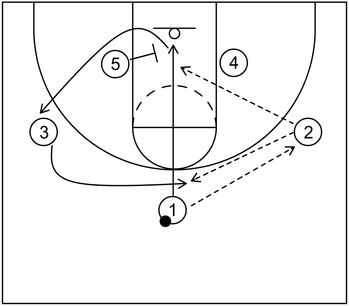
This is an example of continuity scoring options within the 3 out 2 in offense that consists of simple pass and cut action as well as a variation of the standard down screen, known as a pin down screen, near the basket.
To start, 2 receives the ball from 1 and immediately after that, 1 cuts to the basket while 3 fills the vacated spot at the top.
From there, 1 could receive the ball from 2 and score near the rim if that is open. Otherwise, 1 cuts out to the vacated left side wing via the pin down screen set by 3.
Part 2
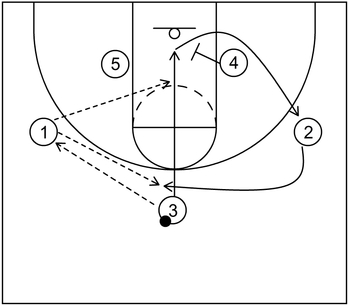
Next, 1 could receive the ball from 3 and take the jump shot if open. If that is not open, then 3 could cut to the basket while 2 cuts to the vacated area at the top.
From there, 3 could receive the ball from 1 and score at the rim or 2 could receive the ball from 1 instead.
Following that action, if 3 did not receive the ball, then 3 could cut to the right side wing via the pin down screen set by 4. From that point, 3 could receive the ball from 2 and the continuity pattern would restart again.
What is an example of continuity scoring options within the 4 out 1 in offense
Part 1
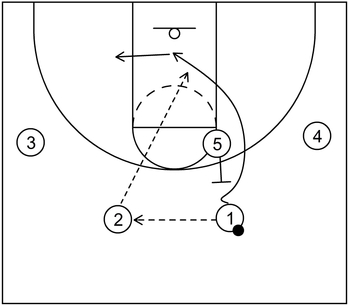
This is an example of continuity scoring options within the 4 out 1 in offense that could be beneficial for guard-oriented teams and/or undersized basketball teams in general.
To begin, 2 receives the ball from 1 and afterwards, 1 cuts to the basket via the back screen set by 5.
If 1 is open, then 1 could receive the ball from 2 near the basket. Otherwise, 1 fills the left side low post block.
Part 2

Next, 2 dribbles toward the right side of the court via a ball screen set by 5 while 3 fills the vacated left slot and 1 fills the vacated left side wing area.
Afterwards, 5 rolls to the basket and could receive the ball from 2 if that is open. On the other hand, if 5 is not open, then 3 receives the ball from 2.
Additionally, 4 cuts to the right side slot area via the screen away action set by 2. Also, as that occurs, 2 fills the right side wing area while 5 cuts to the left side high post elbow area.
From this point, the continuity gets initiated with a sequence featuring a back screen, ball screen, and screen away action.
Part 3
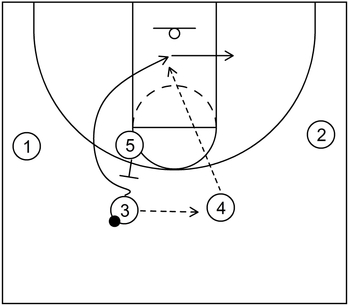
Next, the continuity pattern starts again on the opposite side of the court. 4 receives the ball from 3 and afterwards, 3 cuts to the basket via the back screen set by 5.
If open, 3 receives the ball from 4. On the other hand, if 3 is not able to receive the ball, then 3 fills the right side low post block.
Part 4
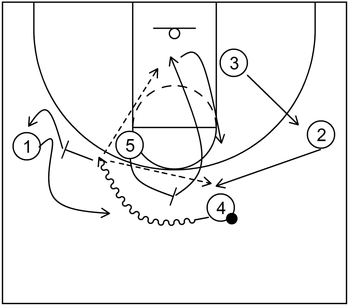
Following that action, 4 dribbles toward the left side of the court via a ball screen set by 5. As that occurs, 5 rolls to the basket while 2 fills the right slot and 3 fills the right side wing area.
From there, 5 could receive the ball from 4 and score near the basket if that is open. If it is not open, then 2 receives the ball from 4 while 1 cuts to the left slot via the screen away action of 4.
Moreover, 4 fills the vacated left side wing area while 5 cuts to the right side high post elbow area. At this point, the continuity pattern can start once again on the other side of the floor.
What is an example of continuity scoring options within the 5 out offense
Part 1
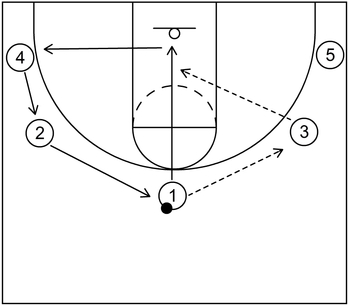
This is an example of the pass and cut continuity scoring options within the 5 out offense. To begin, 3 receives the ball from 1 and after that, 1 cuts to the basket.
As that happens, 2 fills the top while 4 fills the left side wing area. From there, 1 could receive the ball from 3 if open. However, if 1 is not open, then 1 could fill the left side corner.
Part 2
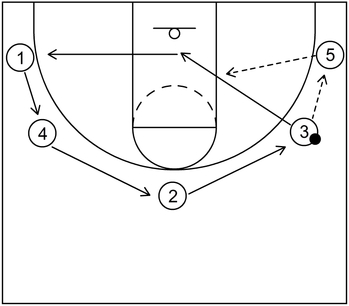
Next, 5 receives the ball from 3 and afterwards, 3 cuts to the basket. As that cutting action occurs, 2 fills the right side wing, 4 fills the top, and 1 fills the left side wing.
Following that, 3 could receive the ball from 5 and score at the rim. If 3 is not open, then 3 continues the cut towards the left side corner.
Part 3

Once 3 fills the left side corner, 2 receives the ball from 5 and from that point, 5 could cut to the basket.
Afterwards, 5 could receive the ball from 2 and score at the basket if open. Otherwise, 5 should execute a self replace cut back to the right side corner.
Part 4
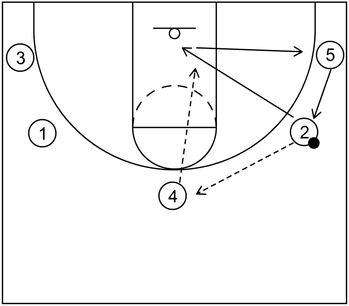
Next, 4 receives the ball from 2 and immediately after, 2 cuts to the basket. Additionally, as that happens, 5 fills the right side wing area. Afterwards, 2 could receive the ball from 4 and score at the rim.
If 2 is not open, then 2 could fill the right side corner. From there, the 5 out motion offense could get executed again as a continuity pattern on the left side of the court.
What is an example of continuity scoring options within the circle offense
Part 1
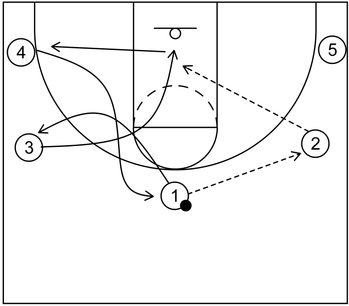
This is an example of the basic continuity scoring options within the circle offense that features a top to wing pass and various cuts from the top, weak side wing, and weak side corner.
To start, 2 receives the ball from 1. Following that, 1 executes a shallow cut near the left side high post and then pops out to the left side wing.
At the same time, 3 executes a cut behind 1 towards the basket. Furthermore, as that happens, 4 cuts behind 3 towards the top.
If 3 is open on the cut towards the basket, then 3 could receive the ball from 2 and score with a layup. If 3 is not open, then 3 continues to cut out towards the left side corner.
Part 2
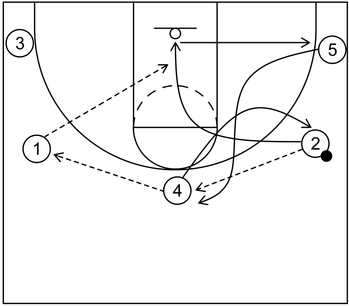
Next, the continuity pattern can begin on the opposite side of the court. 4 receives the ball from 2 and then 1 receives the ball from 4.
After the ball reversal occurs, 4 executes a shallow cut to the right side high post and then pops out to the right side wing.
As that happens, 2 executes a cut behind 4 towards the basket. Also, at the same time, 5 cuts behind 2 towards the top. If 2 is open on the cut to the basket, then 2 could receive the ball from 1 and score with a layup.
If 2 is not open, then 2 continues to cut out towards the right side corner. Afterwards, the continuity could get executed again with ball reversal towards the right side of the floor.
Affiliate Disclosure: I may earn a commission on qualifying purchases made through the links below.
What is an example of continuity scoring options within the Horns offense
Part 1
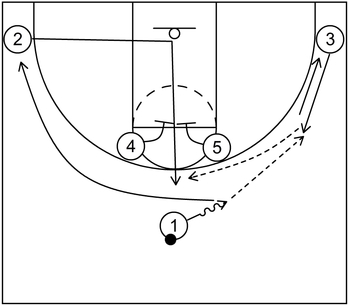
This is an example of continuity scoring options within the Horns offense that could be potentially useful for teams with three-point shooters as it features the elevator screen to create possible scoring opportunities near the perimeter.
It is derived from Encyclopedia of the Elevation Offense by Tyler Whitcomb.
To begin, 1 dribbles toward the right slot and when that occurs, 3 lifts up toward the right side wing area. Following that, 3 could receive the ball from 1.
As that happens, 2 initially cuts toward the basket and afterwards, 2 cuts to the top via the elevator screen set by 4 and 5.
At the same time, as 2 executes the cut, 1 cuts toward the left side corner to fill the vacant area previously occupied by 2.
Next, 2 could receive the ball from 3 and take the open jump shot. Also, after 3 throws the ball, preferably as a chest pass, 3 could cut back towards the right side corner.
Part 2
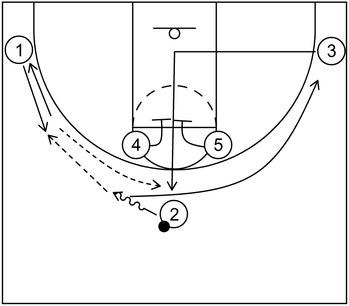
If 2 receives the ball but does not shoot it, that essentially triggers the continuity action of the offense.
Therefore, 2 dribbles toward the left slot and when that happens, 1 lifts up toward the left side wing area. After that, 1 could receive the ball from 2.
As that occurs, 3 initially cuts toward the basket and from there, 3 cuts to the top via the elevator screen set by 4 and 5. At the same time, 2 cuts to the vacant right side corner area.
Following that, 3 could receive the ball from 1 and take the three-point jump shot if open. Moreover, 1 could cut back towards the left side corner.
From that point, if 3 does not shoot the ball, then 3 could dribble towards the right slot to execute the continuity patter again.
What is an example of continuity scoring options within the Princeton offense
Part 1
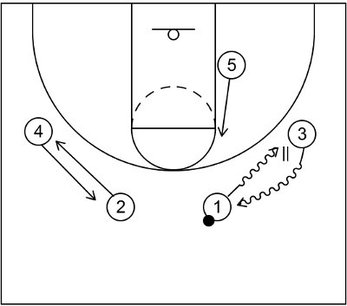
This is an example of continuity scoring options within the Chin series of the Princeton offense.
To begin, 1 executes a dribble handoff with 3 while players 2 and 4 interchange spots on the court. Also, as that happens, 5 lifts up from the low post to the high post area.
Part 2
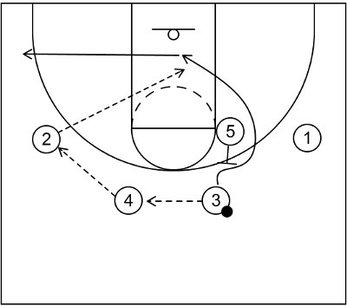
Next, 4 receives the ball from 3 and then 2 receives the ball from 4. Following that, 3 cuts to the basket via the back screen set by 5 and could receive the ball from 2 if open.
If 3 is not open, then 3 continues the cut out towards the left side corner.
Part 3
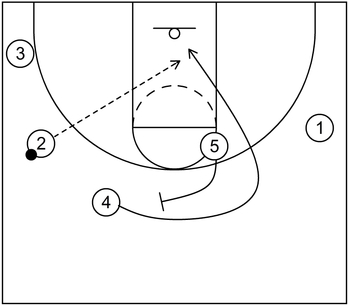
Next, 4 cuts to the basket via the screen set by 5 and could receive the ball from 2 if open near the basket.
Part 4
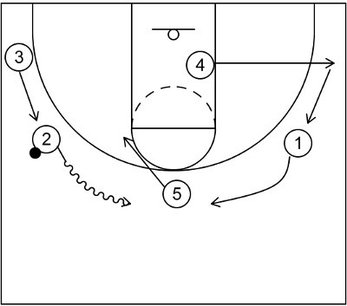
If 4 did not receive the ball from 2, then the chin series flows into the continuity pattern, which would be executed on the opposite side of the floor.
To start the continuity, 4 cuts out to the right side corner and then towards the right side wing. At the same time, 1 cuts up to the right side slot while 2 dribbles to the left side slot.
Also, 5 cuts across to the left side high post area while 3 lifts up from the left side corner to the left side wing.
Part 5
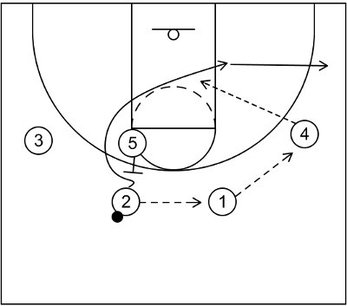
Next, 1 receives the ball from 2 and then 4 receives the ball from 1. Afterwards, 2 cuts to the basket via the back screen set by 5 and could receive the ball from 4.
If 2 does not receive the ball, then 2 cuts out to the right side corner.
Part 6
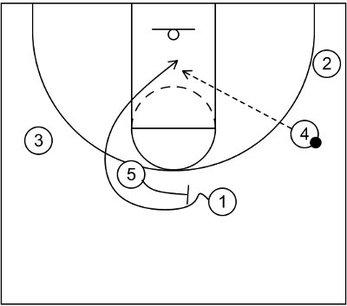
Next, 1 cuts to the basket via the screen set by 5 and could receive the ball from 4 if open. If 1 is not open, then it is possible to execute the continuity once again on the other side of the floor.
What is an example of continuity scoring options within zone offense
Part 1

This is an example of continuity scoring options within a zone offense strategy that utilizes the short corners of the court to create scoring opportunities against the 2-3 zone defense.
To begin, 2 receives the ball from 1 and as that happens, 4 cuts to the right side short corner by way of the cross screen set by 5. Next, 4 can receive the ball from 2 and as that occurs, 5 pivots toward the ball with high hands.
From this point, 4 can either shoot the short corner jump shot if open or 5 could receive the ball from 4 and score with a low post move near the basket.
Also, if 5 does not receive the ball from 4, then 5 can cut away from the ball to the opposite low post block, represented by the gray arrow.
Part 2
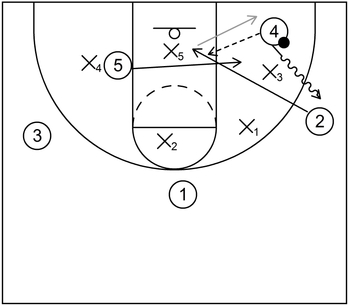
Next, 2 can cut to the basket after making the short corner pass and receive the ball from 4 if that is open. If 2 is not open on the basket cut, then 4 can dribble away from the zone towards the right side wing area.
At the same time, 2 can relocate to the right side short corner, shown with the gray arrow. Also, 5 can cut across the lane to the right side low post area.
Part 3
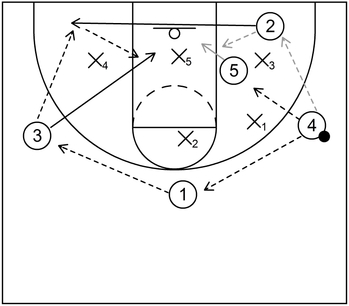
Following that action, 5 can receive the ball from 4 and score with a low post move near the basket. Additionally, 2 can receive the ball from 4, shown with the gray dotted arrow, and take the jump shot if open.
Moreover, 5 could execute a small cut to the basket, receive the ball from 2, and then score near the rim, shown with gray arrows. Conversely, if none of those options are available, then the offensive continuity can begin.
To start the continuity, 1 receives the ball from 4 and then, 3 receives the ball from 1 to complete the ball reversal.
Additionally, at the same time of the ball reversal action, 2 runs the baseline to the left side short corner, receives the ball from 3, and could take the short corner jump shot.
Furthermore, if 2 does not take the jump shot, then 3 could cut to the basket, receive the ball from 2, and score near the rim.
Part 4
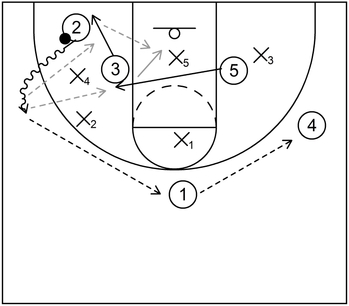
Next, if 3 is not open upon cutting to the basket, then 2 could dribble out towards the left side wing while 3 fills the vacated left side short corner. Additionally, as that occurs, 5 cuts across the lane towards the left side low post block.
From there, 5 could receive the ball from 2 represented by the gray arrow. As another option, 3 could receive the ball from 2 and then 5 can execute a small cut to the basket, also represented by gray arrows.
If those options are not available, then the continuity could get executed once again by 1 receiving the ball from 2 and then 4 receiving the ball from 1.